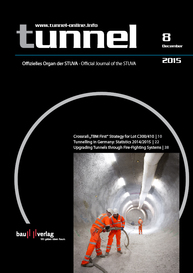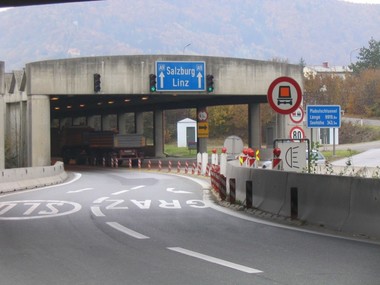Twin-bore Upgrading of the Bosruck Tunnel completed
The 5425 m long Bosruck Tunnel between the states of Upper Austria and Styria has been in operation since 1983, and traffic has been running through a new second bore since summer 2013. After thorough refurbishment of the original bore, the fully improved twin-bore tunnel through the almost 2000 m high Bosruck was opened for traffic on 19 October 2015, equipped with the most modern safety equipment and used by 18 000 vehicles daily. The Austrian autobahn operator ASFINAG has invested 280 million euros in the upgrading and modernisation of the tunnel.
„With the end of two-way traffic in the Bosruck Tunnel, the safety upgrade of the important Pyhrn axis has taken another major step forward. And the autobahn A9 will remain a central feature of our efforts to improve tunnel safety for the coming years,” said ASFINAG chairman Alois Schedl. “At the end of 2018, four further tunnels near Klaus in Upper Austria will have been provided with second bores and thoroughly modernised. By 2019, the Gleinalm Tunnel upgrading in Styria will remove the last bottleneck on the busy north-south link.“
Substantial Refurbishment
The Bosruck Tunnel project was a technical challenge, said Alexander Walcher, managing director of ASFINAG Bau Management GmbH: „Due to the particular geological conditions, we had to renew not only the carriageway but also large parts of the intermediate slab and outer lining of the tunnel. Since the rock mass had increasingly squeezed the tunnel, the new bore was provided with a concrete lining one metre thick and the existing bore was correspondingly upgraded.“
State-of-the-Art Safety Equipment
The Bosruck Tunnel now has the most modern equipment of any tunnel in Europe: light-coloured, reflective tunnel wall coating; kerb reflectors on both sides; a tunnel radio system for traffic news, emergency services and operations personnel; fire-resistant ventilation fans and glass fibre cable for quicker data transmission.
In addition, the tunnel is now equipped with the acoustic early warning system AKUT. This system, developed in collaboration with the research company Joanneum Research from Styria, uses special microphones to detect unusual noises such as a collisions, emergency braking or shouts. The operators in the responsible surveillance centre in Ardning can thus react more quickly to unusual events such as accidents.
Special horn flare loudspeakers are also installed, which make it possible for people in the tunnel to better understand information and instructions from the employees in the surveillance centre.


